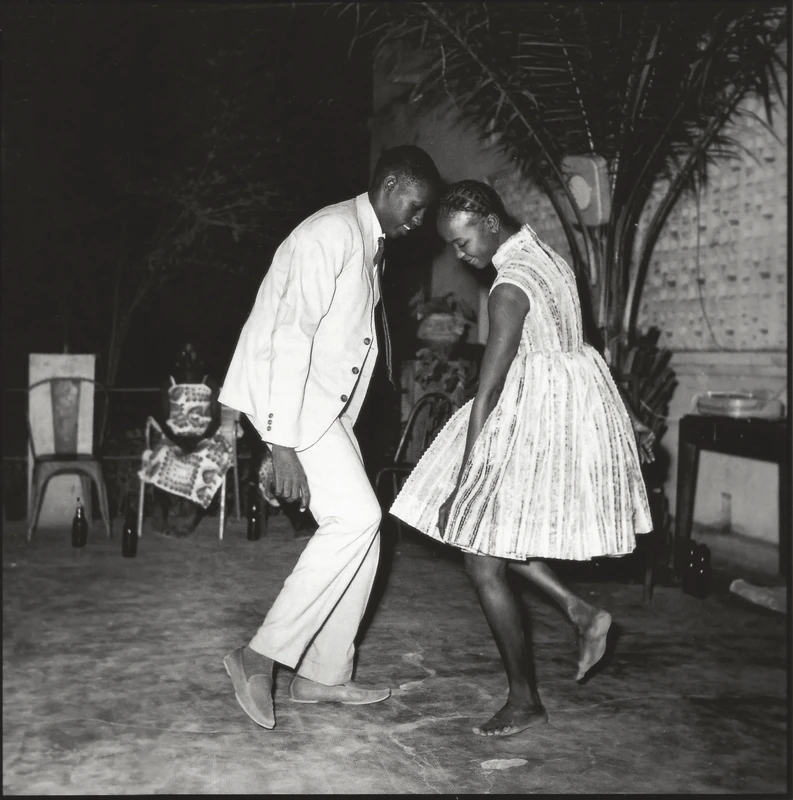Malick Sidibé


b. 1936, Mali
d. 2016
Malick Sidibé was born in 1935, in a small village in Mali. At the age of 10 he was sent to study at one of the colonial schools, where his drawing skills came to the attention of the colonial governor. This opportunity allowed him to start a degree in painting at the prestigious École des Artisans Soudanais in Bamako (currently known as Institut National des Arts). Upon graduation he commenced an apprenticeship for Bamako-based, French photographer Gérard Guillat. While at the studio his duties were limited to handling the cash register and delivered the photos, he bought his first amateur camera in 1956 (a 6 x9 Brownie Flash) and began photographing the reality surrounding him.
Photographing in the City
The first years of Sidibé’s practice as a photographer coincided with Mali’s transformation from a French colony into a modern and independent state. This shift had its influence not only on political but also social and cultural life in the country. Granted with new freedoms, this change impacted strongly the youths who now had access to international music and clothing and who were allowed to attend parties and nightclubs. Being an active participant in the social circles of the city, Sidibé’s main focus was given to photographing the urban life – surprise parties in the evenings, river Niger on hot Sundays, football championships, boxing matches. In the images, the Malians are laughing shown in moments of joy. A sympathetic connection can be noted between the subjects and the photographer: “ I loved the music and the atmosphere, but above all I loved the dancers”, the artist says, “The moments when young people dance and play as though the stars belong to them — that’s what I loved the most.” As a whole, these photographs present 1960s and 1970s Bamako as a lively, cosmopolitan centre where youth asserted their presence as active participants in a changing world.
Studio Malick
Alongside Malick Sidibé’s celebrated documentary photographs of the Bamako nightlife, he also created iconic photographs in his studio. Named ‘Studio Malick’ and operating in the popular neighborhood of Bagadadji, the studio functioned as an important meeting place for the city youth. “The studio was like no other,” he recalls: “It was… relaxed. I did formal family shots, too, but often it was like a party. People would drop by, stay, eat. I slept in the developing room. They’d pose on their Vespas, show off their new hats and trousers and jewels and sunglasses. Looking beautiful was everything.”
Portraits created in Sidibé’s studio reflect the changes that were happening in society. Unlike the official photographs created during the French rule that were used predominantly in the identification documents, on Sidibé’s images Malians were able to represent themselves freely. According to Candace M. Kelle, a specialist in modern African art and photography, in the newly independent country “photography provided Malians with a new medium and venue in which to invent and preserve personal and collective identities.” Through incorporating particular commodities onto the images: cars, cameras, radios, or Western clothing, the subjects were seeking to stress their position as successful and modern. Photography functioned as an important tool in expressing the belonging (actual or desired) to particular social and economic class, allowing people to reclaim the agency over their image and to construct their identities.
Sidibé’s studio portraits are equally dynamic as the photographs created on the streets. The portraits are no longer passive and impersonal as it was in the case of the photographs made prior to the process of decolonization. Sidibé’s images show Malians as confident and active. By incorporating richly patterned textiles or backdrops and other decorative elements, the artist energised the scene. Likewise, the use of low camera angles and elaborated postures of the subjects further emphasised not only their energy but also confidence and individualism. “I didn’t want my subjects to look like mummies. I would give them positions that brought something alive in them” he explained.